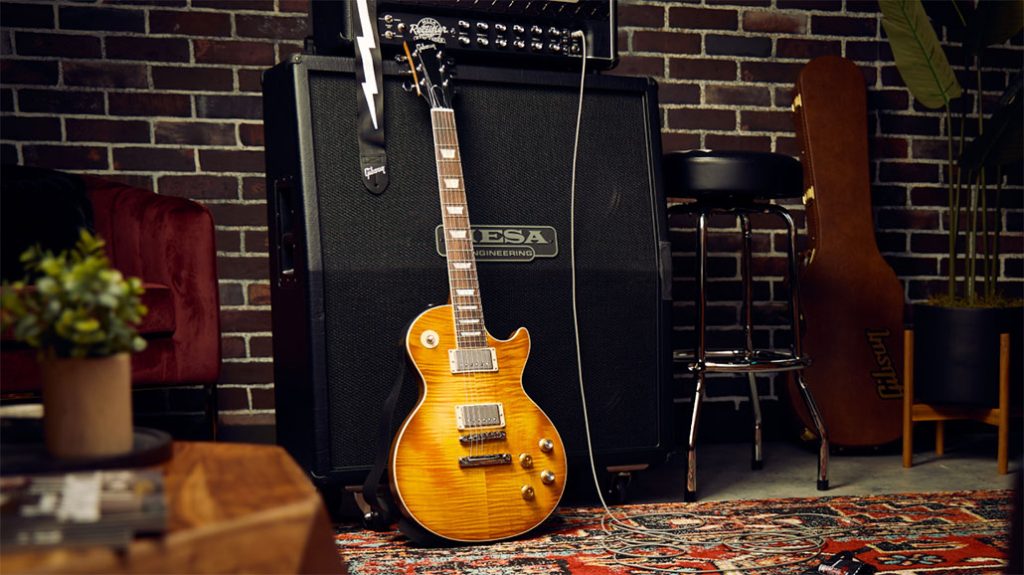From Thin Lizzy to “Parisienne Walkways,” the Northern Irish guitarist was synonymous with the Gibson Les Paul
The Career
From his days with Skid Row and Thin Lizzy to his incendiary solo work, Gary Moore produced some of the most electrifying performances known to stage and studio from the mid-70s onward, evolving from straight-on rock toward becoming the torch-bearer of British blues rock.
Notably more gained-up and over-amped than the blues rockers of the mid to late 60s, Moore’s Les Paul™ style manifested through wide bends and near-endless sustain, a voice probably best exhibited on his instrumental hit “Parisienne Walkways.” Often the cornerstone of his live show, that note—the long-held bend that sustains into an emotive resolve—even became something of a cliché for the player himself, perhaps typifying an over-cooked style that the guitarist was trying to move away from.
In 2001, he told The Guitar Magazine, “There used to be these two guys that followed me around who used to sit there at the edge of the stage every night and time the note with a stopwatch. I’d come out after a gig, and they’d say, ‘Well, Gary, you went for one minute and twenty-seven seconds tonight. Are you going to go for the full two minutes tomorrow . . . ?’”
There’s no questioning the greatness of the Irish guitar legend, who died on February 6, 2011, at age 58, while vacationing in Spain. What’s worth asking is why he wasn’t on the same pedestal as his fellow Gibson Les Paul demi-gods, Eric Clapton, Jeff Beck, and Jimmy Page.
After all, he had it all for electric guitar firepower: chops, melodic imagination, and tone—a tone as big as anything Jimmy Page plastered on Led Zeppelin’s early albums. Maybe Moore, nearly a decade younger than the members of the British Guitar Triumvirate, was just a little behind the curve of six-string immortality that swept them up. Or maybe, as the American sonic rock guitar wizard Reeves Gabrels, a huge Moore fan, suggests, Moore’s Belfast ancestry swept him into the long-running complexities between the English and the Irish.
At any rate, to quote an old English aphorism, “the proof is in the pudding,” and Moore offered evidence of his greatness at every turn of his career. His undeniable genius is embedded in numbers like the steel-toed melodic jazz-rock masterwork “Parisienne Walkways,” the Celtic-flavored shred fest “Over the Hills and Far Away,” and his other epic compositions.
Looked at from one angle, the main Les Paul in question here, Greeny, first achieved its legendary status in the hands of Fleetwood Mac-era Peter Green. But its second prominent owner, Irish guitarist Gary Moore, was himself a prime exponent of sizzling British blues rock Les Paul tone, and he certainly earned his spot in the pantheon of Les Paul greats. That, and it’s fascinating to track the travels of a single Les Paul that made legendary music through the course of three iconic owners, currently in the stable of Metallica’s Kirk Hammett.
Hammett told Guitar World:
“I’ve always thought of Greeny as an anomaly, just as a result of the way it looks and sounds and everything it’s been through,” Kirk Hammett says. “It’s a unique, solitary instrument.”
However, Gibson Brand President Cesar Gueikian and Kirk Hammett made a discovery about Greeny and a newly purchased vintage Les Paul in Gueikian’s collection. “We realized the two guitars have sequential serial numbers,” Gueikian said, “and our minds were blown.”
Gueikian’s instrument, which he and Hammett nicknamed Gemini (the symbol for “twin”), is serial number 9 2204. Greeny is 9 2208. Research and company records revealed that no other guitars were manufactured between them—the intervening serial numbers correspond to Gibson Skylark amplifiers.
Currently, Gibson Custom Shop offers a replica of Greeny.
“I’ve always thought of Greeny as an anomaly, just as a result of the way it looks and sounds and everything it’s been through,” Kirk Hammett says. “It’s a unique, solitary instrument.”

Gary Moore purchased his most famous 1959 Les Paul from Peter Green in the mid 1970s, some years after Green had retired from his position with Fleetwood Mac, and virtually abandoned guitar playing altogether.
While Green’s playing had embraced the subtlety and nuance of which a great Les Paul is capable, Moore’s arguably typified the power and punch that is more commonly associated with “the Les Paul tone.” He also acquired a second ’59 Burst that was frequently used for recording and touring. After 37 years in Moore’s hands, the guitar was auctioned in 2006, beginning with an asking price of $2-million and made its post-auction debut on display at the Dallas Guitar Show in 2007.
The other half of Moore’s historic tonal equation was a Marshall. The ideal tool is a 50-watt head with a 4×12 or 2×12 cabinet, to get some air moving, or a “Bluesbreakers” style combo. Moore set his amp’s dials with gain at half-mast, treble at roughly seven, mids up to 9 for a warm core sound, bass at five (to roll off some lows) and presence at five for extra definition, handy for punching out the fleet solos with distinct, crisp single notes that were his calling card.

Having established himself as a prime exponent of heavy electric blues, played in a dramatic style typified by the example above (perhaps best exemplified on the Still Got The Blues), Moore’s 2001 album Back To The Blues saw the guitarist bidding for more authenticity in his playing. “There was a lot of over-playing on Still Got The Blues,” he told The Guitar Magazine. “I think I’ve got away from that—but it’s taken me ten years to do it.”
Gibson produced a Gary Moore Signature Les Paul Standard around 2000-2001 (with a faded lemonburst finish and a reversed neck pick, a mod undertaken during Peter Green’s ownership) and a modified Gary Moore BFG Les Paul with a P-90 in the neck position.
Hear Greeny in action here in our Spotify playlist.

